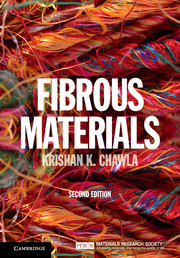Book contents
- Frontmatter
- Dedication
- Contents
- Preface to the Second Edition
- Preface to the First Edition
- Acknowledgments
- 1 Introduction
- 2 Fibers and fibrous products
- 3 Natural polymeric fibers
- 4 Synthetic polymeric fibers
- 5 Electrospun fibers
- 6 Metallic fibers
- 7 Ceramic fibers
- 8 Glass fibers
- 9 Carbon fibers
- 10 Experimental determination of fiber properties
- 11 Statistical treatment of fiber strength
- Appendix: Some important units and conversion factors
- Indexes
- Plate section
- References
1 - Introduction
Published online by Cambridge University Press: 05 June 2016
- Frontmatter
- Dedication
- Contents
- Preface to the Second Edition
- Preface to the First Edition
- Acknowledgments
- 1 Introduction
- 2 Fibers and fibrous products
- 3 Natural polymeric fibers
- 4 Synthetic polymeric fibers
- 5 Electrospun fibers
- 6 Metallic fibers
- 7 Ceramic fibers
- 8 Glass fibers
- 9 Carbon fibers
- 10 Experimental determination of fiber properties
- 11 Statistical treatment of fiber strength
- Appendix: Some important units and conversion factors
- Indexes
- Plate section
- References
Summary
The term fiber conjures up an image of flexible threads, beautiful garments and dresses, and perhaps even some lowly items such as ropes and cords for tying things, and burlap sacks used for transporting commodities, etc. Nature provides us with an immense catalog of examples where materials in a fibrous form are used to make highly complex and multifunctional parts. Protein, which is chemically a variety of complexes of amino acids, is frequently found in nature in a fibrous form. Collagen, for example, is a fibrous protein that forms part of both hard and soft connective tissues. A more well-known natural fiber, which is essentially pure protein, is silk fiber. Silk is a very important natural, biological fiber produced by spider and silkworm. It is spun from a solution; the solution, in this case, being produced by the silkworm or the spider. Silkworm silk has been commercialized for many years. However, scientists and engineers are beginning to realize the potential of silk, in general, and spidersilk, in particular.
Indeed, materials in a fibrous form have been used by mankind for a long time. Yarns made of fibers have been used for making fabrics, ropes, and cords, and for many other uses since prehistoric times, long before scientists had any idea of the internal structure of these materials. Weaving of cloth has been an important occupation in most ancient societies. The term fabric is frequently employed as a metaphor for societal characteristics. One talks of the social fabric or moral fiber of a society, etc. It is interesting to note that an archeological excavation of a 9000-year-old site in Turkey led to the discovery of a piece of fabric, a piece of linen, woven from the fibers of a flax plant (New York Times, 1993). Normally, archeologists date an era by the pottery of that era. It would appear from this discovery that textile fabrics came even before pottery. There is also recorded use of sutures as stitches in wound repairs in prehistoric times (Lyman, 1991). An ancient medical treatise, about 800 BC, called The Sushruta Samhita, written by the Indian surgeon Sushruta, describes the use of braided fibers such as horse hair, cotton fibers, animal sinews, and fibrous bark as sutures. Incidentally, the word suture comes from the Sanskrit word, sutra meaning filament or thread.
- Type
- Chapter
- Information
- Fibrous Materials , pp. 1 - 10Publisher: Cambridge University PressPrint publication year: 2016



